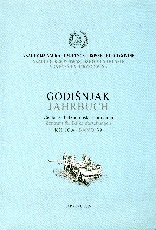Tekstualna konstrukcija svetog mjesta na primjeru predaje o slici Gospe s Kondžila
The Textual Construction of a Holy Place. The Example of Kondžilo
Author(s): Mario KatićSubject(s): Cultural history, Visual Arts
Published by: Akademija Nauka i Umjetnosti Bosne i Hercegovine
Keywords: Kondžilo; Visual art; Cultural history; Oral literature;
Summary/Abstract: In this article I tried to analyze all available records about the saga of the painting of Our Lady from Kondžilo. On the basis of their textual and contextual analysis I tried to offer some new insights. According to division of the oral literature by Vlajko Palavestra the saga of the painting of Madonna from Kondžilo belongs to the thematic group of historical-religious sagas. The story begins on the 7th September 1779, when Bishop Mark Dobretić visited Komušina. This is the first written record of the painting of Our Lady of Kondžilo. Although it can be assumed that this is the same figure, which is still located in Komušina and carried to Kondžilo, it is not explicitly stated in this record. After that no one wrote about that painting until 1877, when English archaeologist, writer and adventurer Arthur J. Evans, published the book: Walking Through Bosnia and Herzegovina. Ten years after Evans we have the first written record of the saga that explains the „arrival“ of the painting to Komušina and the begining of pilgrimage to Kondžilo. Pastor of Komušina, Blaž Ikić, in two brief articles in the Journal of the Yugoslav Franciscans from 1888 wrote about his trip in 1887 with the pastor from Sivša, Jozo Ilaković and pastor from Žabljak, Ambraz Rajković, to the village of Mrkotić with the intention to learn more about the saga (Ikić 1888: 137). The priest heard about the saga from some older people from the parish Komušina, where the painting by then was revered for more than a hundred years. From this short saga we learned a lot of information: the painting is not from Komušina, but actualy from Mrkotić, a remote Muslim village three hours’ walk away. She was kept in the family granary of Kapetanović, who later became Capljić. The painting was found by their ancestor hedges in their fields.
Journal: Godišnjak Centra za balkanološka ispitivanja
- Issue Year: 2010
- Issue No: 39
- Page Range: 219-239
- Page Count: 21
- Language: Bosnian

